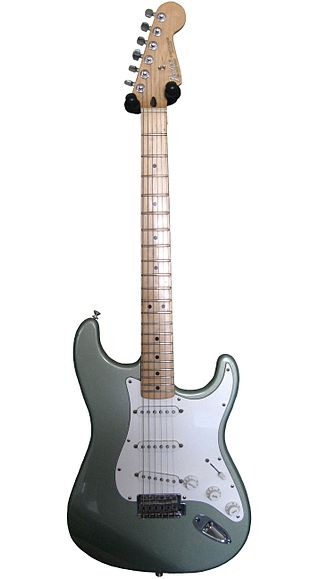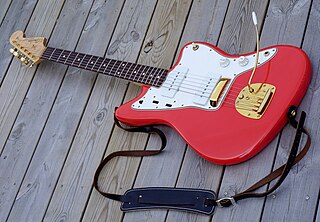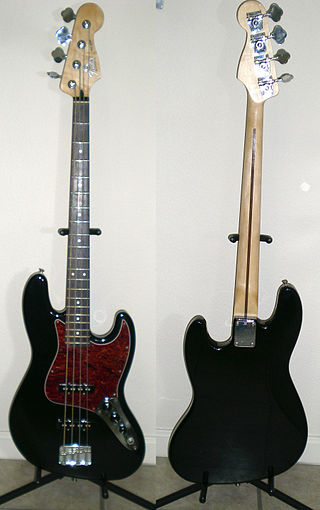
The Fender Stratocaster, colloquially known as the Strat, is a model of electric guitar designed between 1952 and 1954 by Leo Fender, Bill Carson, George Fullerton, and Freddie Tavares. The Fender Musical Instruments Corporation has continuously manufactured the Stratocaster since 1954. It is a double-cutaway guitar, with an extended top "horn" shape for balance. Along with the Gibson Les Paul, Gibson SG, and Fender Telecaster, it is one of the most-often emulated electric guitar shapes. "Stratocaster" and "Strat" are trademark terms belonging to Fender. Guitars that duplicate the Stratocaster by other manufacturers are sometimes called S-Type or ST-type guitars.

The Fender Jazzmaster is an electric guitar designed as a more expensive sibling of the Fender Stratocaster. First introduced at the 1958 NAMM Convention, it was initially marketed to jazz guitarists, but found favor among surf rock guitarists in the early 1960s. Its appearance is similar to the Jaguar, though it is tonally and physically different in many technical ways, including pickup design, scale length and controls.
The Fender Jaguar is an electric guitar by Fender Musical Instruments characterized by an offset-waist body, a relatively unusual switching system with two separate circuits for lead and rhythm, and a short-scale 24" neck. Owing some roots to the Jazzmaster, it was introduced in 1962 as Fender's feature-laden top-of-the-line model, designed to lure players from Gibson. During its initial 13-year production run, the Jaguar did not sell as well as the less expensive Stratocaster and Telecaster, and achieved its most noticeable popularity in the surf music scene. After the Jaguar was taken out of production in 1975, vintage Jaguars became popular first with American punk rock players, and then more so during the alternative rock, shoegazing and indie rock movements of the 1980s and 1990s. Fender began making a version in Japan in the mid-1980s, and then introduced a USA-made reissue in 1999. Since then, Fender has made a variety of Jaguars in America, Mexico, Indonesia and China under both the Fender and Squier labels. Original vintage Jaguars sell for many times their original price.

The Fender Precision Bass is a model of electric bass guitar manufactured by Fender Musical Instruments Corporation. In its standard, post-1957 configuration, the Precision Bass is a solid body, four-stringed instrument usually equipped with a single split-coil humbucking pickup and a one-piece, 20-fret maple neck with rosewood or maple fingerboard.

The Fender Jazz Bass is the second model of electric bass created by Leo Fender. It is distinct from the Precision Bass in that its tone is brighter and richer in the midrange and treble with less emphasis on the fundamental frequency. The body shape is also different from the Precision Bass, in that the Precision Bass has a symmetrical lower bout on the body, designed after the Telecaster and Stratocaster lines of guitars, while the Jazz Bass has an offset lower bout, mimicking the design aesthetic of the Jaguar and Jazzmaster guitars.

The Fender Cyclone denotes a series of electric guitars made by Fender. Introduced in late 1997, the Cyclone body is similarly styled to the Mustang, but it is a quarter of an inch thicker than the body of a Mustang and is made of poplar, whereas contemporary Mustang reissues were made of basswood.

Charvel is a brand of electric guitars founded in the 1970s by Wayne Charvel in Azusa, California and originally headquartered in Glendora, California. Since 2002, Charvel has been under the ownership of Fender Musical Instruments Corporation.

The Squier '51 is an electric guitar made by Squier, a subsidiary of Fender. The '51 is notable for being one of the few original designs made by Squier, which normally manufactures less expensive authorized copies of Fender's popular guitars and bass guitars.

Fender Contemporary Stratocaster electric guitars were produced by Fender Japan in the 1980s.
Pensa Custom Guitars is an American company that manufactures electric guitars and basses in handmade fashion. The company is based in New York City. Pensa Custom Guitars was founded by Argentine businessman Rudy Pensa.

The Fender Noiseless series is a line of electric guitar pickups made by the Fender Musical Instruments Corporation designed to cancel 60 cycle (Hz) hum noise while retaining the characteristic sound of single coil pickups. Introduced in 1998, these pickups consist of a pair of single coils stacked one on top of the other, compacted so as to match the shape and width space as a traditional Fender single coil guitar pickup, while being only slightly taller. The upper coil is actually the sound source, while the lower coil is responsible for the mains hum attenuation. Alnico V magnetic bars span from one coil to the other, crossing a soft ferrous steel spacer plate that isolates them, without touching it. The spacer plate has mainly two functions: to isolate the lower coil from the vibrations of the string, making sure that the sound is picked up only from the upper one, and to increase the magnetic flux that passed through both coils, increasing the output of the pickup. This is to be contrasted with the original noise canceling pickup, the humbucker, which is a double-wide, horizontally adjacent pair of single coil pickups with opposing phase.
The James Burton Telecaster is a Signature/Artist Series electric guitar made by Fender Musical Instruments Corporation. The guitar is available in two models, Upgrade and Standard, and both were designed by American country-rock guitarist James Burton along with Dan Smith at Fender. Both models are patterned after mid-century Fender Telecaster guitars played by Burton during his long career with Ricky Nelson, Elvis Presley, Merle Haggard, Emmylou Harris, John Denver and many other well-known artists.
The Fender American Deluxe Series was a line of electric guitars and basses introduced by Fender in 1995 and discontinued in 2016. It was upgraded in 2004 and 2010 before being replaced by the American Elite series in 2016.
The Jeff Beck Stratocaster is an electric solid body guitar made by Fender Musical Instruments for British guitarist Jeff Beck. This Artist Signature guitar was introduced in 1991 and upgraded ten years later. The Custom Shop version, introduced in 2004, is available in Olympic White and Surf Green finishes.
The Fender Elite Stratocaster is an electric solid body guitar that was manufactured by Fender in 1983 and 1984. The name was revived from 2016 to 2019 with the Fender American Elite Stratocaster Series.

The Stevie Ray Vaughan Stratocaster is the signature model electric guitar of American guitarist Stevie Ray Vaughan, based on his favorite guitar, Number One. The guitar debuted at the NAMM Show in January 1992 and began selling at various music stores.
The Fender Telecaster, colloquially known as the Tele, is an electric guitar produced by Fender. Together with its sister model the Esquire, it was the world's first mass-produced, commercially successful solid-body electric guitar. Its simple yet effective design and revolutionary sound broke ground and set trends in electric guitar manufacturing and popular music.

The Fender Cabronita Telecaster is a class of guitars built by Fender Musical Instruments Corporation based on their Telecaster body shape. The name Cabronita is Spanish slang and roughly translates as little bastard or little devil. While retaining the shape and general feel of a Telecaster, they are a radical departure from the traditional electronics and sounds associated with the instrument. Like virtually all Telecaster submodels, they are labeled simply as a Fender Telecaster on the headstock logo, identifiable only by their features.












